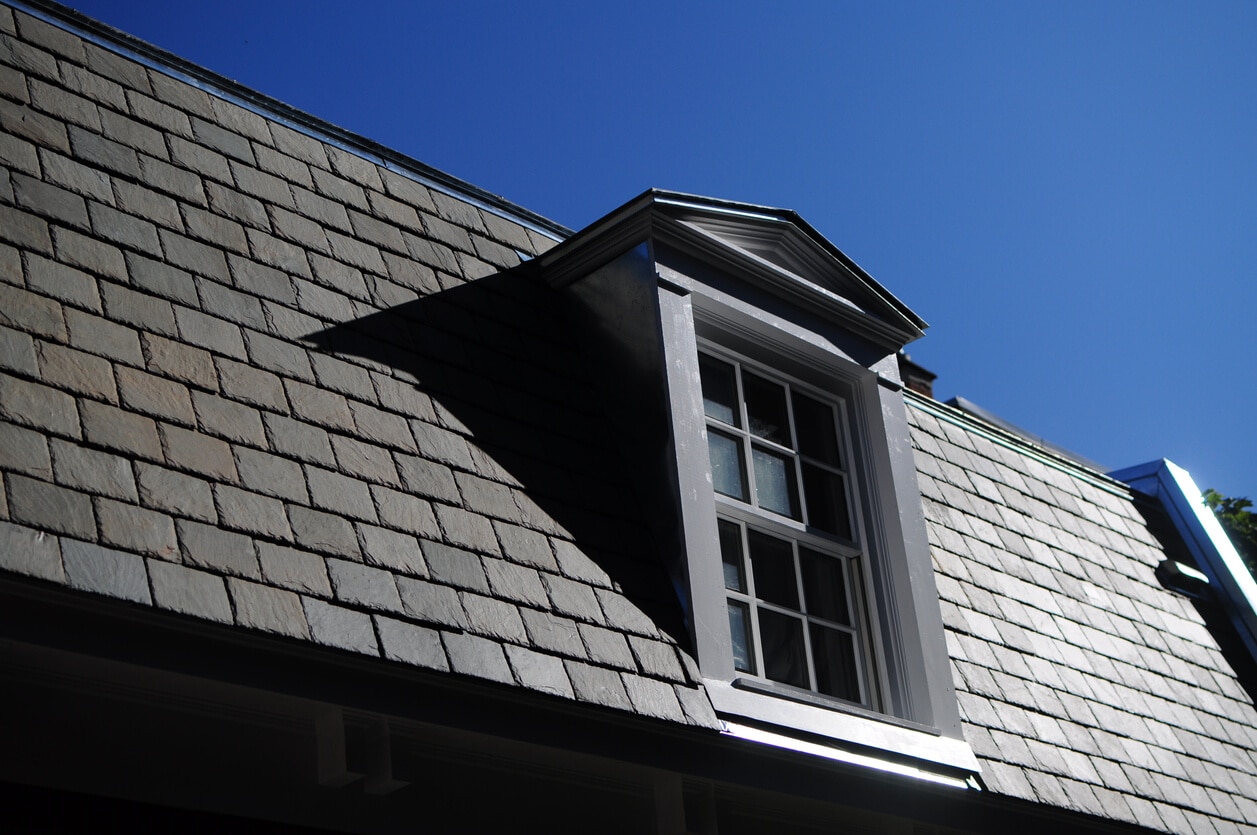
Slate roofs are a different breed. Elegant, durable, and often centuries old, they’re not just another line item on a home maintenance checklist, they’re part of your home’s identity.
So when something goes wrong, calling the average roofer for a slate roof repair is like asking a general practitioner to perform delicate heart surgery. They may mean well, but without deep experience, the result could be more harmful than helpful.
In Atlanta’s historic neighborhoods, where slate roofs crown some of the city’s most architecturally significant homes, homeowners aren’t just looking for someone with a ladder and a toolbox. They’re looking for craftsmen who understand the material, the method, and the mistakes to avoid.
The problem? Not all roofing contractors are the same, and when it comes to slate, shortcuts aren’t just risky, they’re expensive.
So, what sets true slate roof repair specialists apart from the rest? And how can you avoid turning a minor repair into a major rebuild? Let’s break it down.
What Makes Slate Roofing Unique—and Repairing It Tricky
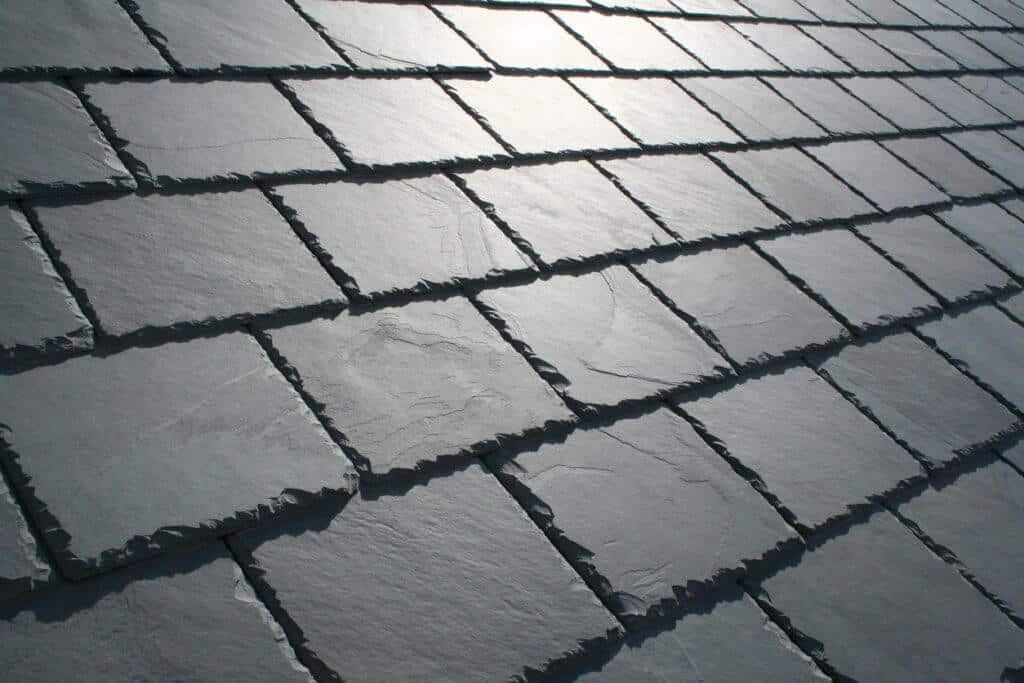
Slate isn’t your average roofing material. It’s a natural stone, hand-cut and installed piece by piece. And while it’s known for its beauty and longevity, those same qualities make slate roof repair a highly specialized task.
Here’s why it’s not something just any roofer should tackle.
Natural Stone: Heavy, Brittle, and Installed Differently From Shingles
Shingles vs slate tiles for roofing is quite a debate. But unlike asphalt shingles, slate tiles are rigid and heavy, averaging 800 to 1,000 pounds per square (100 square feet). Each tile is fastened with nails or hooks in a specific pattern, often with copper or stainless steel. One wrong step and a slate can crack, or worse, send a chain reaction through the surrounding tiles.
While shingles are forgiving, slate is anything but. If a contractor isn’t used to working with natural stone, they’re likely to treat it like composite roofing, and that’s where trouble begins. Simply walking on a slate roof without the right equipment or training can cause costly damage.
Slate Roofs Can Last 75-150 Years, but Repairs Require Matching Material and Technique
Slate is built for endurance, with some slate roofs outliving the homes beneath them. However, that longevity relies on proper repairs using:
- Matching slate type (color, size, origin—like Pennsylvania or Vermont slate)
- Historic techniques, including proper nail lengths, copper flashings, and mortar standards
- Specialized tools, like slate rippers and hammers
Hiring someone unfamiliar with these details often results in mismatched tiles, awkward patches, or moisture problems down the line. That’s why residential slate roof repair should always be done by experts who’ve worked with slate specifically, not just roofing in general.
Why General Roofers Often Cause More Damage When Working on Slate
A general roofer might be great with asphalt, but slate is a different world. They may:
- Walk directly on the tiles and break them
- Use nail guns (a big no-no for slate)
- Patch with sealants or tar instead of replacing tiles
- Leave exposed nail heads that lead to leaks
These “quick fixes” often lead to more calls to slate roof repair specialists, but by then, the damage may have spread. It’s not about being picky; it’s about preserving an investment that was built to last generations.
Common Causes of Slate Roof Damage in Atlanta
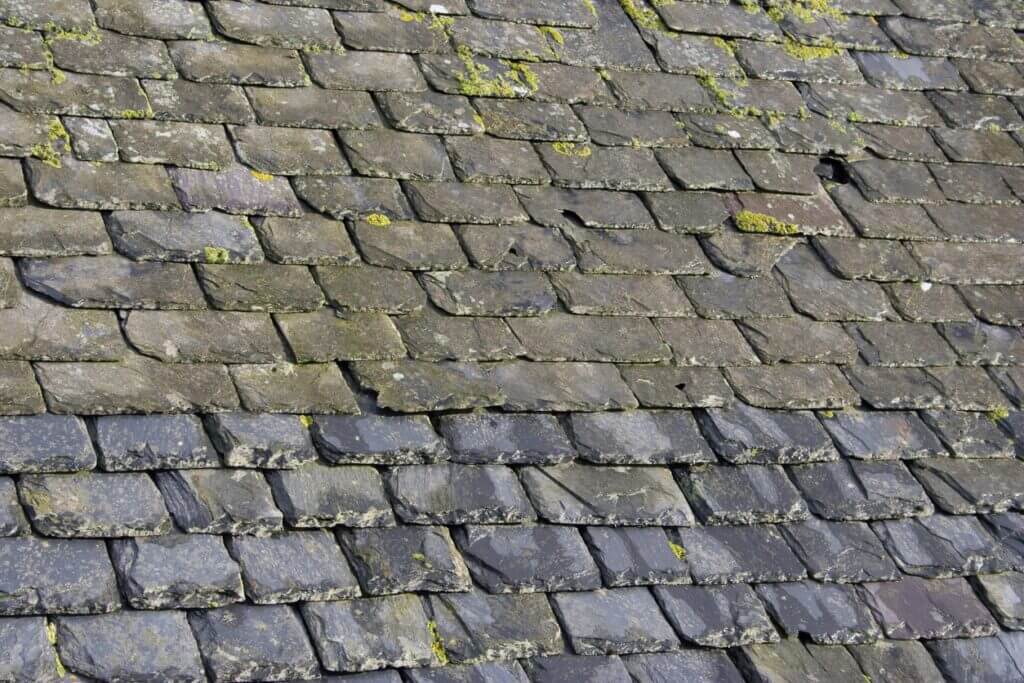
Atlanta’s climate has no shortage of extremes, from steamy summers to the occasional ice storm, and slate roofs take the hit. Here’s what commonly leads homeowners to call slate roof repair companies near me in this region.
1. Foot Traffic or Improper Inspections
You’d be surprised how often well-meaning home inspectors or HVAC technicians unknowingly crack slate tiles just by walking on them. Unlike composite shingles, slate isn’t meant to be walked on. Even experienced inspectors should use ladders or drones rather than setting foot on a slate roof.
This type of damage often isn’t visible from the ground, making regular slate tile roof repair near me searches common among historic home owners who want a second opinion.
2. Nail Fatigue and Slate Slippage
Over time, the nails that hold the slate in place, usually made of copper or galvanized steel, can corrode or loosen, especially in Georgia’s humid conditions. This leads to:
- Loose or sliding slates
- Exposed nail holes
- Water intrusion beneath the tile
Once nails give out, slates start slipping, especially after heavy rains, and that’s when it’s time to call a slate roof repair contractor who can safely remove and replace affected tiles without disturbing the surrounding ones.
3. Hail and Storm Impact Cracks
Atlanta sees its fair share of hailstorms, and while slate is durable, it isn’t invincible. Hail can:
- Crack tiles clean through
- Chip edges, causing water seepage
- Loosen existing nails or fasteners
What’s worse? These cracks can be hairline-thin and hard to spot, until the next big rain. A thorough inspection by slate roof repair specialists can uncover these issues before they escalate.
4. Aging Copper Flashing or Underlayment Issues
Even if your slates are still solid, what’s underneath them might not be. Most slate roofs rely on copper flashing, which can last 50-70 years, but after that, it begins to deteriorate. Similarly, old underlayment (especially in homes that haven’t been updated in decades) may dry rot, allowing water into the structure.
Signs to watch for:
- Leaks around chimneys or valleys
- Corrosion stains near flashing
- Damp spots in attics or walls
This kind of repair goes beyond surface tiles, making it essential to work with a slate roof repair company that understands the full roof system.
5. Ice Dams and Poor Drainage
It’s not just a Northern problem; Atlanta gets its share of icy mornings. When melting snow refreezes at the eaves, it creates ice dams that force water under the tiles. Combine that with poor gutter drainage or clogged downspouts, and you’ve got a recipe for water damage beneath even the tightest slate installation.
Professionals trained in residential slate roof repair can install proper ventilation, check flashing, and ensure water flows where it should—away from your home.
Signs You Need Slate Roof Repairs
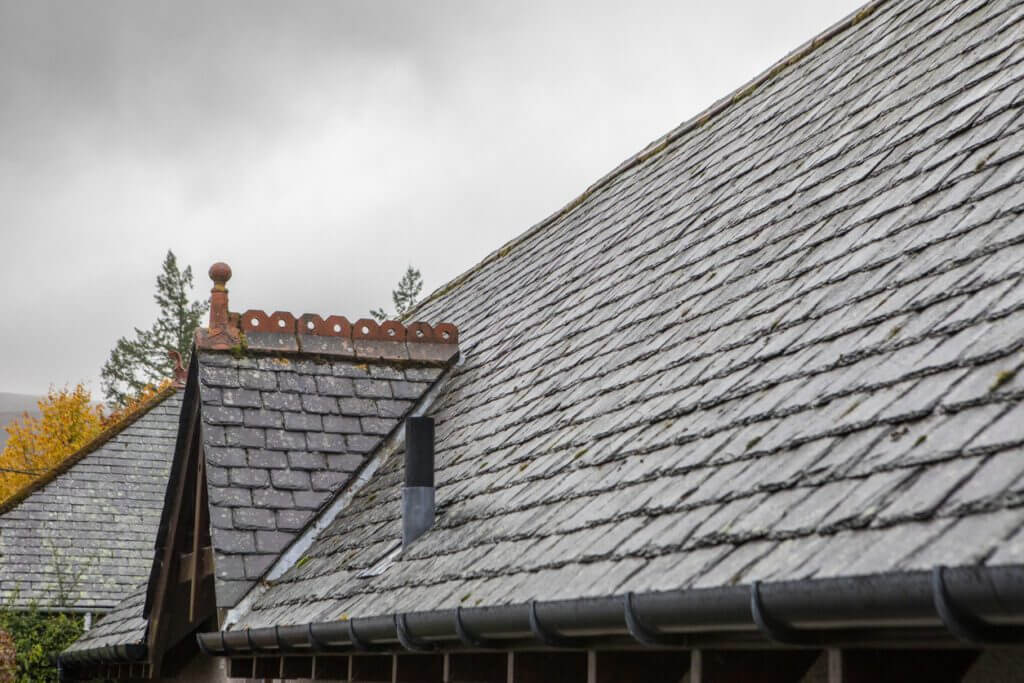
Not all slate roof issues scream for attention. Some whisper until it’s too late. Because slate roofs age gracefully, many homeowners assume “no news is good news.” But like any historic feature, a slate roof gives off subtle warnings when it needs help. Spotting them early can save you thousands in future repairs.
To make it easy, here’s a quick summary of what to look for before we break each one down:
Signs | What It Means | What to Do |
Missing or Slipped Tiles | Nail fatigue or physical impact | Call a slate roof repair specialist |
Cracked or Delaminated Slate | Age or storm damage | Replace damaged tiles |
Water Stains Inside | Flashing or underlayment issues | Inspect the attic and roof system |
Sagging Ridges or Valleys | Structural degradation or improper support | Schedule a professional assessment |
Rusting or Separated Flashing | Aging metalwork or failed seams | Have a slate roof repair company inspect it |
Now, let’s take a closer look.
1. Missing or Slipped Tiles
A slipped slate is more than an eyesore—it’s an open invitation for water intrusion. Slates usually slide out due to rusted nails (a.k.a. “nail sickness”) or improper installation. If you see any gaps, ask a slate roof repair contractor to investigate. DIY attempts usually result in cracked adjacent tiles or botched nail placements that compromise the whole area.
2. Cracked, Delaminating, or Spalled Slate Pieces
If you notice flakes peeling off your slate or actual cracks running through a tile, that’s delamination or spalling, common in aging or lower-quality slate. This kind of damage weakens the tile and allows water in behind it, where it can freeze, expand, and break more tiles. Spot a few of these? Time to call one of the reputable slate roof repair companies near me and schedule a proper inspection.
3. Water Stains on Ceilings or Attic Decking
This one’s subtle but serious. Even if your slate looks fine from the ground, water stains inside your home, especially around chimneys, skylights, or along rafters, often mean the flashing or underlayment is compromised. Water has likely found a path under your tiles. Don’t ignore this.
Residential slate roof repair pros can identify exactly where the intrusion begins and fix it without disturbing unaffected sections.
4. Sagging Ridges or Valleys
Slate is heavy, and when ridge lines or valleys start to sag, it can signal structural trouble—rotted decking, failed supports, or prolonged water exposure. This isn’t a cosmetic issue; it can lead to major collapse if left unchecked.
If you see sagging, call a slate roof repair company that works specifically with slate systems, not just any general roofer.
5. Rusting or Separated Flashing
Your slate may last 100 years, but flashing won’t. If you see green stains (oxidized copper), rust streaks, or gaps around chimney or valley flashings, water is likely sneaking in. This is one of the most common calls for slate roof repair near me searches, and it’s not a DIY fix.
Proper flashing requires technique, specialty materials, and the right touch to blend in without damaging the surrounding slate.
When Slate Repairs Aren’t Enough: Partial Reroofing or Restoration
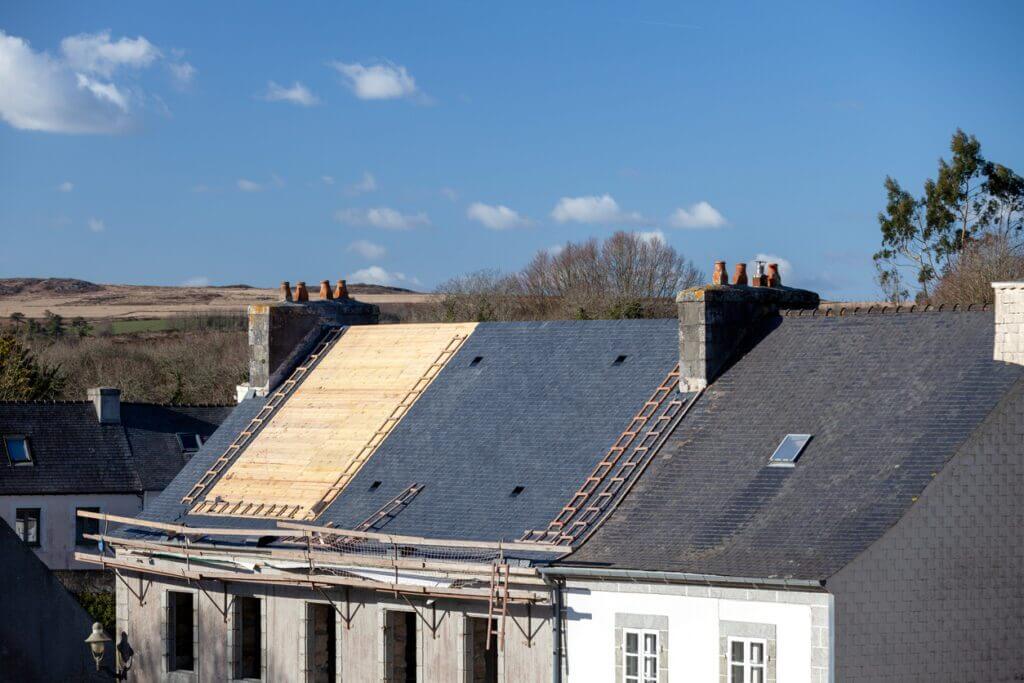
There comes a point where slate roof repair isn’t enough to keep your roof functional or cost-effective. While spot repairs work well for isolated issues, sometimes the underlying structure is too far gone.
That’s where restoration or partial reroofing enters the picture. Don’t worry: this doesn’t mean gutting your entire roof. In most cases, a thoughtful, phased approach can preserve as much of your original slate as possible, without sacrificing protection.
When More Than 20% of the Roof Is Compromised
If more than a fifth of your slate tiles are cracked, slipping, or missing, it’s usually more practical to consider partial reroofing. Trying to patch dozens (or hundreds) of slates individually leads to mounting labor costs and still leaves you with a roof at risk. Slate roofs are interlocked systems, and when too many pieces are damaged, the integrity of the whole system starts to fail.
This is often the turning point when homeowners start hearing “restoration” from slate roof repair specialists instead of simple repairs.
When Fasteners or Battens Have Failed Throughout
Even if your slates look fine, the nails and battens (support boards) underneath may not be. In older Atlanta homes, it’s common to find rusted iron nails or rotted battens hiding beneath slate that’s technically still intact. This type of hidden failure can cause widespread slate slippage, leaks, and sagging.
When fastener issues are widespread, targeted repairs don’t solve the underlying problem. A slate roof repair contractor with restoration experience can lift the slates, address the support structure, and reinstall or replace tiles section by section.
Options: Section-By-Section Repair vs. Full Replacement
There’s a big difference between tearing off a roof and restoring it by zones. Here are the two main approaches:
- Section-By-Section Repair: Best for large but localized damage (e.g., one side affected by a tree fall or hail). This keeps costs down and preserves the original slate where possible.
- Full Replacement: Reserved for cases where structural issues, severe aging, or poor installation exist throughout. New slate, matched as closely as possible, is installed with new underlayment and flashing.
Reputable slate roof repair companies will evaluate both options and walk you through cost, timeline, and aesthetics. Be wary of any contractor pushing full replacement without a compelling reason.
Mr. Roofer’s Approach: Only Recommend Replacement When Clearly Justified
At Mr. Roofer of Atlanta, we’ve earned the trust of homeowners by following one simple rule: never recommend replacement unless it’s the smartest and most cost-effective long-term option.
Our slate experts will always explore repair, partial reroofing, and restoration before ever suggesting full replacement. We respect the integrity of your home’s original materials and believe in preserving architectural history wherever possible.
Conclusion
Slate roofs are a legacy of craftsmanship, history, and durability. But even the best roofs need the right kind of attention to stay strong for another generation. Whether you’re seeing slipped tiles, spotting attic leaks, or suspect your roof needs more than a quick patch, the key is to work with trusted slate roof repair specialists who know the difference between preservation and shortcuts.
If you’ve been searching for slate roof repair near me or you’re not sure what your roof really needs, Mr. Roofer of Atlanta is here to help. Our team combines deep experience with honest assessments and fine craftsmanship.
Schedule your slate roof inspection today, and get the peace of mind that your home’s most important feature is in expert hands.
